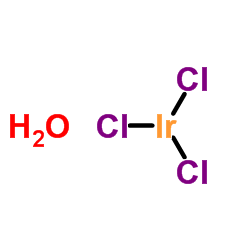Iridium(III) chloride hydrate
Modify Date: 2025-08-25 10:02:56

Iridium(III) chloride hydrate structure
|
Common Name | Iridium(III) chloride hydrate | ||
|---|---|---|---|---|
| CAS Number | 14996-61-3 | Molecular Weight | 316.591 | |
| Density | 5.3 g/mL at 25 °C(lit.) | Boiling Point | N/A | |
| Molecular Formula | H2Cl3IrO | Melting Point | 763°C (dec.) | |
| MSDS | Chinese USA | Flash Point | N/A | |
| Symbol |

GHS07 |
Signal Word | Warning | |
| Name | Iridium(III) Chloride Hydrate |
|---|---|
| Synonym | More Synonyms |
| Density | 5.3 g/mL at 25 °C(lit.) |
|---|---|
| Melting Point | 763°C (dec.) |
| Molecular Formula | H2Cl3IrO |
| Molecular Weight | 316.591 |
| Exact Mass | 315.880035 |
| PSA | 9.23000 |
| LogP | 2.00420 |
| InChIKey | MJRFDVWKTFJAPF-UHFFFAOYSA-K |
| SMILES | Cl[Ir](Cl)Cl.O |
| Symbol |

GHS07 |
|---|---|
| Signal Word | Warning |
| Hazard Statements | H315-H319-H335 |
| Precautionary Statements | P305 + P351 + P338 |
| Personal Protective Equipment | dust mask type N95 (US);Eyeshields;Gloves |
| Hazard Codes | Xi: Irritant; |
| Risk Phrases | R36/37/38 |
| Safety Phrases | S26-S36 |
| RIDADR | 3260 |
| WGK Germany | 3 |
|
The virtue of defects: stable bromine production by catalytic oxidation of hydrogen bromide on titanium oxide.
Angew. Chem. Int. Ed. Engl. 53(33) , 8628-33, (2014) Rutile TiO2 is a heavily investigated oxide with, to date, scarce applications in industrial catalysis. The inactivity of this material in oxidations has been related to its inability to dissociate mo... |
| Iridium trichloride hydrate |
| MFCD00149749 |
| Trichloroiridium hydrate (1:1) |
| Iridium chloride hydrate |
| Iridium chloride(III) hydrate |
| IrCl3,Iridium trichloride hydrate |
| Iridium(III) chloride hydrate |
| EINECS 233-044-6 |

